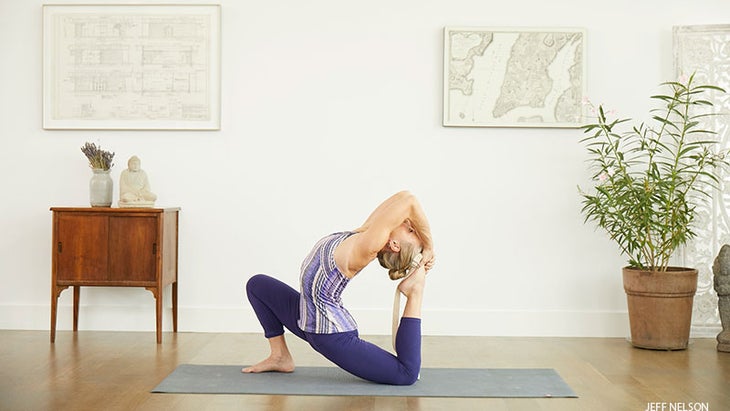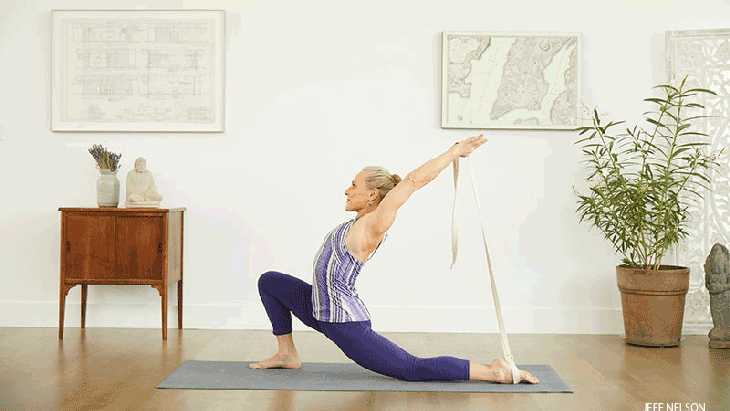Heading out the door? Read this article on the new Outside+ app available now on iOS devices for members! Download the app.

Senior Intermediate Iyengar teacher Carrie Owerko knows how to find the surprisingly fun angles and elements of Iyengar Yoga. Owerko has partnered with Yoga Journal to bring you a six-week interactive online course in which she’ll share playful ways to use props and apply Iyengar principles and wisdom to your practice and life off the mat. Sign up now for a creative journey that will profoundly deepen and transform your approach to yoga and perspective on BKS Iyengar’s unique method.
King Pigeon Pose (Eka Pada Rajakapotasana) is one of those wonderfully challenging postures that requires both stability and mobility—easier said than done. Most yoga poses ask of us the same, but this one is particularly demanding. It requires you to remain aware, secure, and fluid, all at once, in order to avoid injury. Let’s call it “stable fluidity.” If you aren’t stable in your legs and core, you’ll topple over; if you aren’t fluid in your hips and spine, you risk forcing the pose and hurting yourself.
King Pigeon Pose is about balancing these two extremes, in both your body and mind. And these three creative, Iyengar-inspired variations can help you access the pose and its benefits, or move deeper into the stretch.
Learn to pause along the way as you explore the process of the pose. Pause, reflect, and observe your senses of perception. Are your eyes, tongue, and skin soft and relaxed? Don’t move on to the next stage until they are. It’s OK if that takes days, weeks, months… Remember: Yoga is at its heart a practice of waking up and being fully present and aware to what is arising.
“On this path of yoga, no effort is ever wasted, and there is no failure. Even the smallest effort toward awareness will protect you from the greatest fear.” —Bhagavad Gita, Chapter 2, verse 40
OK, grab a strap, folding chair, and blanket and let’s get started!
Note: Be sure to warm up properly. First practice poses that elongate your hip flexors as well as those that increase the range of motion in your shoulders and upper back. Include some one-legged standing asanas to bring stability to your hip and pelvic regions, as well as some preparatory backbends such as Cobra (Bhujangasana), Upward-Facing Dog Pose (Urdhva Mukha Svanasana), and Upward Bow Pose (Urdhva Dhanurasana), to warm up the spine.
King Pigeon Pose with a Strap

To assist tight shoulders
a. From a kneeling position, step one foot forward and come into a deep lunging position. Squeeze the sides of your pelvis in toward your core and lift your lower abdominal region, so that you remain balanced in the pose. Bend you back leg and place the loop of a strap around your left foot. Hold the end of the belt in both hands. Press the top of your left foot into the floor and lift your arms upward. Take a few breaths here.
b. Begin to bend your back leg, but continue to resist that foot into the strap as you bend your arms, walk your hands down the strap, and draw the foot in toward your head. Take your time. Pause and observe your body breathing. Keep resisting your back foot into the strap, even as you pull it in. This is what we call in Iyengar Yoga an opposing, or double, action. This opposing action will help open and extend the front of your left hip.
c. When your hands come to your foot, or as close as is possible, inhale and lift up through your chest. As you exhale, take your head back. Stay in the pose for 10-30 seconds, as you maintain your balance and observe your body breathing as a stable and integrated whole.
d. Slowly release the strap as you come up and out of the pose. Repeat on the other side. Make sure to take a restorative pose, like Child’s Pose, to counter the actions of King Pigeon.
See also Iyengar 101: Yoga Teacher Carrie Owerko’s Personal Story
King Pigeon Pose at the Wall

To deepen the hip flexor stretch
a. Place the loop of the belt on your back foot, as you did above. Come to all fours and place your back shin up against a wall. Come to an upright position, stacking your shoulders over your hips.
b. Take hold of the end of the strap again and lift your arms upward. Take a few deep breaths. Press your back foot into the wall (as you pressed it into the strap in the last variation) to provide the resistance that will help move your pelvis forward and deeper into your lunge. Keep squeezing your hips in toward your core and lift your abdominal region.
c. Continuing those actions and crawl your hand down the strap. Pause and breath along the way. Crawl your hands down the strap until you find your foot or come a close as is possible. Inhale, and as you exhale press your foot into the wall, lift up through your chest and take your head back. Stay in the pose with steady breathing. Relax your tongue and jaw. Observe how this helps to release unnecessary tension in the whole body.
d. Come up and out of the pose slowly. Repeat on your other side. This variation can be even stronger than the first as the wall provides quite a lot of resistance for the foot and shin of the back leg. Counter with Child’s Pose.
See also Iyengar Yoga 101: Stomach-Turning Pose (aka Can’t-Fail Core Work)
King Pigeon Pose with a Chair

To get deeper into both shoulders and hips
a. Kneel in front of a chair (against a wall). Place one ankle or lower leg against the front of the chair seat and step your other foot forward. Come into your lunge and take a few breaths.
b. As you inhale, reach your arms up and back toward the wall and the upper part of the chair. Exhale and come back to your upright lunge. Repeat this movement several times. Keep your outer hips squeezing in, your lower abdominal area and the sides of your trunk uplifted as you do these movements. Observe the flow of your breath as you relax your tongue, eyes, and jaw.
c. Now reach your left arm backward, extending your arm from your shoulder as you eternally rotate your upper arm and turn your palm up toward the ceiling. Take a breath. Once you have positioned your hand on the chair, with your palm facing up, exhale and lift your elbow. Inhale and lift your chest; exhale as you take your head back and reach your opposite arm to the chair as well. If possible, walk your hands further down the chair, pausing to observe the movement of your breath. Maintain stability in your pelvic region as you inhale and lift upward though your sides. And then as you exhale, take your head back to, or toward, your back foot. Stay here for a few breaths. Observe your senses of perception and learn to keep them relaxed while you are in the pose.
d. Come up and out slowly. Repeat on your other side. Then take a counter pose.
Note: This variation can also be done with a strap as in 1 and 2. Or stay with the movement described in b, arching up and back toward the chair.
See also Iyengar 101: What You Didn’t Know + Myths Debunked
About Our Expert
Carrie Owerko is a Senior Intermediate Iyengar teacher based in New York City. She continues her studies with the Iyengar family by traveling to India on a regular basis, as well as by continuous in-depth studies with her yoga teacher, Patricia Walden. Before studying yoga, Carrie earned a BFA in dance and theater and became a Certified Movement Analyst. Curiosity, openness, and affection are of utmost importance in her approach to Iyengar Yoga, as is the integration of science, yoga philosophy, and poetic imagination. Most importantly, she loves to explore the relationship of discipline and playfulness and is a firm believer in the power of controlled folly. Learn more at carrieowerko.com